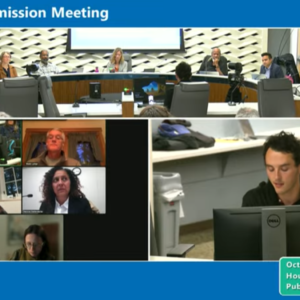From AASHTO:
WITHDRAWAL OF AASHTO REGULATORY RECOMMENDATION REGARDING USDOT BICYCLE AND PEDESTRIAN GUIDANCE
In response to the concerns expressed by several members of AASHTO’s Board of Directors, President Martinovich has directed AASHTO for the time being to withdraw its request that FHWA rescind its guidance on the meaning of “due consideration” of bicycle and pedestrian needs. This will give AASHTO an opportunity to meet with bicycle and pedestrian advocacy groups on May 19 to discuss this issue. It will also allow time for AASHTO’s Board of Directors at our annual meeting in October to discuss this issue and provide policy direction on how best to deal with it. Several state DOT CEOs have expressed the concern that this issue is not one that the Board was briefed on, or one on which they were asked to take a position. We will brief the Board more fully on this matter at our meeting May 6.
Background. April 1, 2011, I responded to a U.S.DOT notice asking for a review of regulations to identify those we found to be outmoded, ineffective, or excessively burdensome. After consultation and input from the states, AASHTO submitted a list of approximately 30 regulations that States wanted improved.
One of the recommendations states submitted was for a change to FHWA’s guidance on implementing the statutory requirements related to bicycle and pedestrian facilities in the planning and design of highway projects. Our intent in making the request that the guidance be changed is to streamline the effort and paperwork required to justify why bicycle or pedestrian facilities may or may not be appropriate on a given federal aid project.
The statutory language calls for bicyclists and pedestrians to be given “due consideration” in the development of comprehensive transportation plans, and to “be considered, where appropriate, in conjunction with all new construction and reconstruction of transportation facilities.” We have no problem with this requirement.
What we have objected to is FHWA guidance which increases the level of requirement from “consideration” to “accommodation.” The guidance says “that bicyclists and pedestrians will be accommodated” which is a much more expansive requirement in that states must prove exceptional circumstances when not providing for bicyclists and pedestrians as part of a federal aid highway project.
We reported on AASHTO’s recommendations regarding regulatory change in the AASHTO Journal April 8. The article contained links to AASHTO’s submittal letter and to a 15-page supplemental document which contained the text of our recommendations regarding the bicycle and pedestrian guidance.
Our comment on FHWA’s guidance has apparently caused concern in the bicycle community. When contacted in this regard by the League of American Bicyclists and the National Center for Bicycling and Walking, I offered to meet with them and others to hear their concerns and to explain what we recommended and why. A meeting has been scheduled for May 19 here at AASHTO.
You may receive similar contacts from bicycling and pedestrian interests in your state or community. We hope you will share with them our support for bicycling and pedestrian facilities, as well as our interest in limiting FHWA’s guidance to what was defined in the law.
Executive Director John Horsley, April 22, 2011
Here is a link to the full explanation as submitted to USDOT, http://bit.ly/RegulatoryReviewRequest (PDF).





Thanks for reading.
BikePortland has served this community with independent community journalism since 2005. We rely on subscriptions from readers like you to survive. Your financial support is vital in keeping this valuable resource alive and well.
Please subscribe today to strengthen and expand our work.